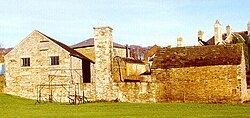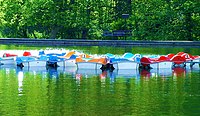Millhouses
| Millhouses | |
| Yorkshire West Riding | |
|---|---|
 Ecclesall Mill, Millhouses | |
| Location | |
| Grid reference: | SK333834 |
| Location: | 53°20’48"N, 1°30’0"W |
| Data | |
| Post town: | Sheffield |
| Postcode: | S7 |
| Dialling code: | 0114 |
| Local Government | |
| Council: | Sheffield |
| Parliamentary constituency: |
Sheffield Hallam |
Millhouses is a neighbourhood in south-western suburbs of Sheffield, in the West Riding of Yorkshire. It stands on the north-west bank of the River Sheaf, which forms the border of Derbyshire.
The origins of Millhouses are in a small hamlet that grew around the Ecclesall Corn Mill.[1] Its population was estimated in 2006 as 4,424.
The agriculture and industries of this area are now largely gone, leaving Millhouses as a mostly residential area. The area has three schools, a 32-acre park, three pubs, three supermarkets, three churches and numerous small shops.
Running directly alongside the River Sheaf is the long and thin Millhouses Park. The Midland Main Line also runs through Millhouses. Residential development was in a fan-shape focussed on the junction of Abbeydale Road and Millhouses Lane. Most houses in the area were built in the 1920s although there are some that date from the late 19th century.
History
In ancient times this area was part of the Barnsdale Forest. In the late 12th century Robert Fitz Ranulf gave land for the establishment of an abbey, just south of Millhouses at Beauchief. Over time most of the area now covered by Millhouses had been given to the abbey by the De Ecclesall family.[2] One of the gifts to the monks was the Ecclesall Corn Mill. This mill existed at least as early as 1280 and considerable remnants of it can still be seen at the north end of Millhouses Park.
Millhouses remained mostly agricultural until the 19th century, although two cutlery works had been established in the area: Moscar Wheel, which may originally have been a corn mill, was making cutlery by 1496, and Bartin Wheel was built as a cutler's wheel in 1631.
In 1805 a turnpike road was built from Sheffield to Bakewell (now Abbeydale Road), this passed through the area and led to some growth, but it was only with the extension of the Midland Main Line through the valley in 1870 (with a railway station at Millhouses) and the subsequent arrival of trams in 1902 that Millhouses began to develop as an affluent residential suburb. As well as a railway station, an engine shed was built in 1901.[3] This closed in the 1962, but the shed building is still in use as an industrial site and the shed's sidings are now Tesco supermarket's Park and Ride.
Noteworthy buildings in Millhouses include the Grade II listed parish church, Holy Trinity, which was constructed in 1937,[4] and the former Millhouses police station building that dates from 1893.[5] The Robin Hood and Wagon and Horses public houses are amongst the neighbourhood's older surviving buildings, both dating from earlier than 1822.[6]

Millhouses Park
Between Abbeydale Road South and the River Sheaf lies a mile-long public park, with a mixture of green spaces, planted areas and leisure facilities. These include tennis courts, a boating lake and a café.
| ("Wikimedia Commons" has material about Millhouses) |
References
- ↑ Vickers, Old Sheffield Town, p. 71
- ↑ Hunter, Joseph (1819). "The Township of Ecclesall Byerlow". Hallamshire. The History and Topography of the Parish of Sheffield in the County of York. London: Lackington, Hughes, Harding, Mayor & Jones. pp. 195–219.
- ↑ Fox, Peter (1990). The Midland Line in Sheffield. Sheffield: Platform 5 Publishing Ltd. ISBN 1-872524-16-8.
- ↑ National Heritage List 1255061: Church of Holy Trinity (Grade II listing)
- ↑ National Heritage List 1246460: Park Lodge, former police station (Grade II listing)
- ↑ Baines, Edward: 'History, Directory and Gazetteer of the County of York' (1823)
- Harvey, Peter (1996). Abbeydale and Millhouses. Stround: The Charlford Publishing Company Limited. ISBN 0-7524-0732-5.
- Vickers, J. Edward MBE (1999). Old Sheffield Town. An Historical Miscellany (2nd ed.). Sheffield: The Hallamshire Press Limited. ISBN 1-874718-44-X.
